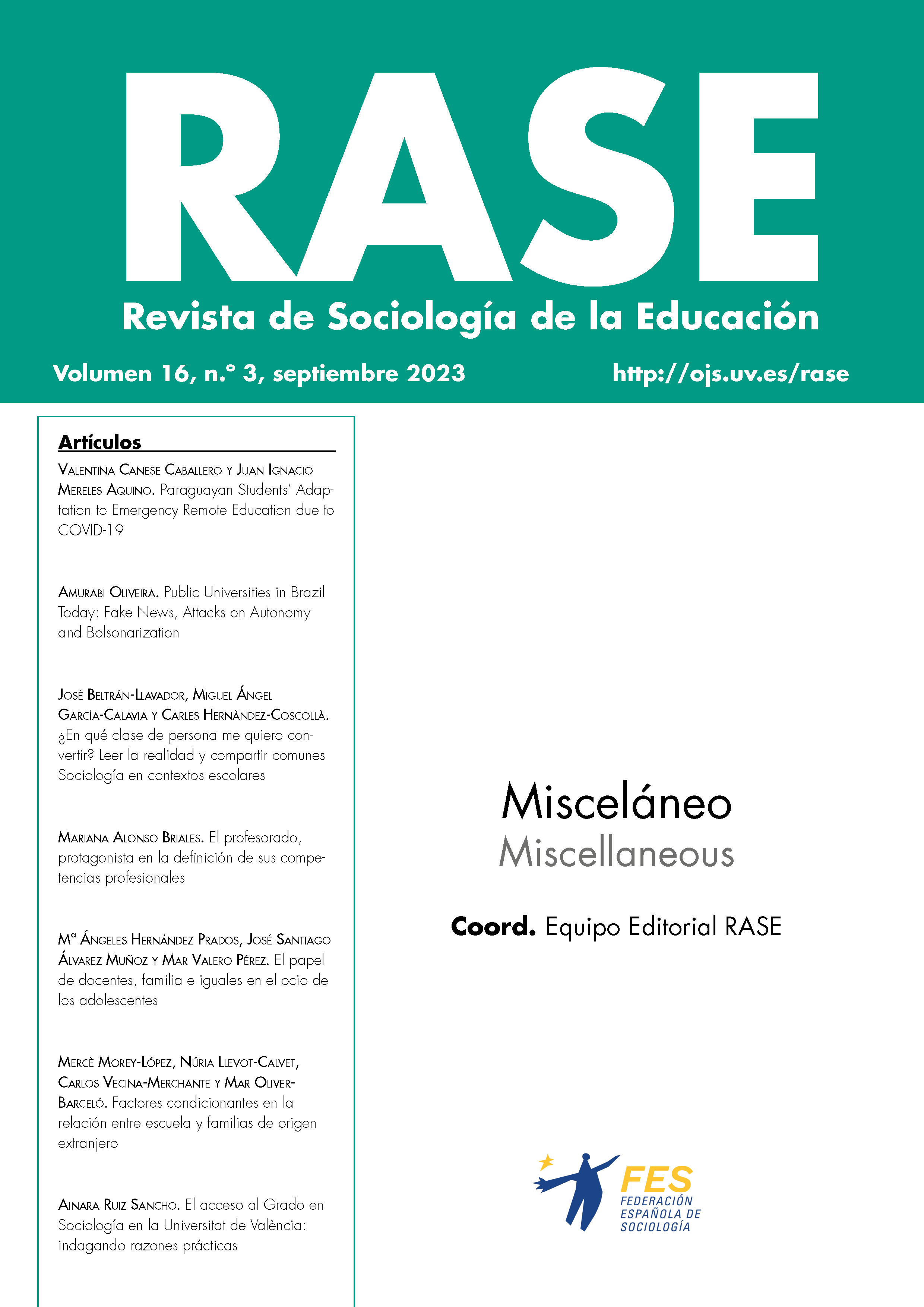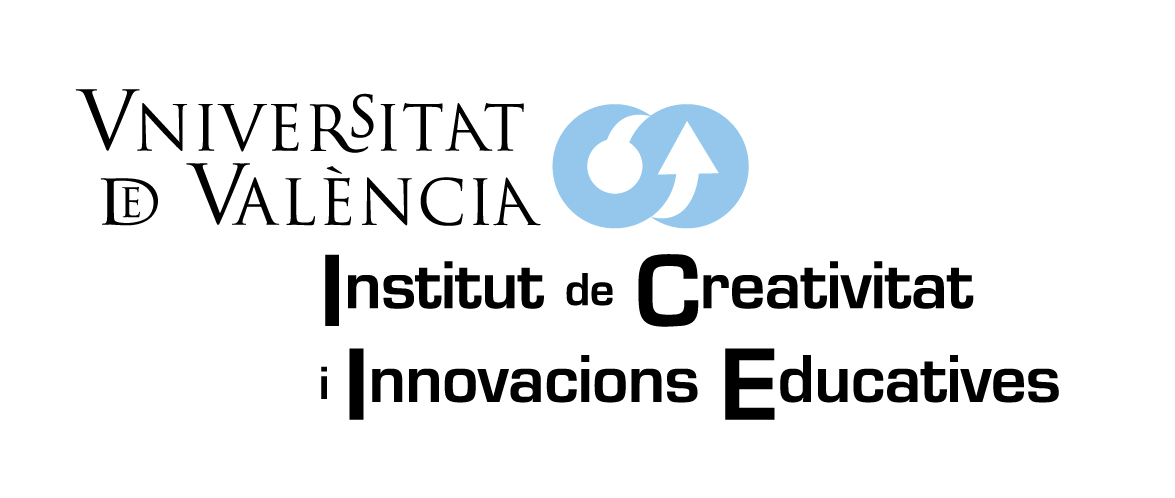Paraguayan Students’ Adaptation to Emergency Remote Education due to COVID-19
DOI:
https://doi.org/10.7203/RASE.16.3.24007Keywords:
Remote virtual education, ICT, pandemic, students Abstract
Abstract
In 2020, education underwent significant changes due to COVID-19, requiring all educational stakeholders to adapt to virtual learning to salvage the academic year. This paper examines the experiences of high school and university students during this period. The study was conducted in two phases: the initial weeks of the transition to virtual learning and the final two months of the year. The findings revealed notable transformations in technological access, particularly outside the capital. The use of computers increased, and internet usage grew across all sectors and regions. Communication platforms also experienced widespread adoption. However, students faced various challenges during ICT-mediated learning. Common difficulties included task comprehension, time constraints, and internet connectivity issues. Despite these obstacles, students' satisfaction with ICT for learning purposes increased by the end of 2020. This indicates their resilience and adaptability in embracing technology to continue their education amidst adversity. The study emphasizes the need for ongoing support and resources to address these challenges, including improving task understanding, allowing sufficient time for completion, and addressing connectivity issues. Moreover, the growing satisfaction observed toward the end of the year suggests the potential for lasting changes in educational practices. It is crucial to capitalize on this transformation and effectively integrate technology into future teaching and learning approaches. By acknowledging the hurdles faced and leveraging the lessons learned, education can be adapted to better meet students' needs, fostering an inclusive and dynamic learning environment in an uncertain future.
 Downloads
Downloads
 References
References
Aguilera-Hermida, A. P. (2020). “College students’ use and acceptance of emergency online learning due to COVID-19”. International Journal of Educational Research Open, 1, 100011. https://doi.org/10.1016/j.ijedro.2020.100011
Albelbisi, N. A., & Yusop, F. D. (2019). “Factors influencing learners’ self–regulated learning skills in a massive open online course (MOOC) environment”. Turkish Online Journal of Distance Education, 20(3), 1-16. https://doi.org/10.17718/tojde.598191
Almendingen, K., Morseth, M. S., Gjølstad, E., Brevik, A., & Tørris, C. (2021). “Student’s experiences with online teaching following COVID-19 lockdown: A mixed methods explorative study”. PloS one, 16(8), e0250378. https://doi.org/10.1371/journal.pone.0250378
Aristovnik, A., Keržič, D., Ravšelj, D., Tomaževič, N., & Umek, L. (2020). “Impacts of the COVID-19 pandemic on life of higher education students: A global perspective”. Sustainability, 12(20), 8438. https://doi.org/10.3390/su12208438
Aucejo, E. M., French, J., Araya, M. P. U., & Zafar, B. (2020). “The impact of Covid-19 on student experiences and expectations: Evidence from a survey”. Journal of Public Economics. NBER Working Paper No. w27392. https://ssrn.com/abstract=3632618
Canese, V., Mereles, J. I., & Amarilla, J. (2021). Educación remota y acceso tecnológico en Paraguay: perspectiva de padres y alumnos a través del COVID-19. Trilogía Ciencia Tecnología Sociedad, 13(24), 41-63. https://doi.org/10.22430/21457778.1746
Casero Béjar, M. O., & Sánchez Vera, M. M. (2022). “Cambio de modalidad presencial a virtual durante el confinamiento por Covid-19: percepciones del alumnado universitario”. RIED. Revista Iberoamericana de Educación a Distancia, 25(1), 243-260. https://doi.org/10.5944/ried.25.1.30623
CEPAL. (2020). La educación en tiempos de la pandemia de COVID-19. https://repositorio.cepal.org/bitstream/handle/11362/45904/1/S2000510_es.pdf
CONACYT. (2021). Indicadores de Ciencia y Tecnología de Paraguay 2020. Asunción, Paraguay.
Chávez-Miyauchi, T.-E., Benítez-Rico, A., Alcántara-Flores, M., Vergara-Castañeda, A., & Ogando-Justo, A. (2021). “Personal motivation and learning self-management in students, as result of the transition to online courses during COVID-19 pandemic”. Nova Scientia, 13(spe). 1–16. https://doi.org/10.21640/ns.v13ie.2739
Cortés, M. E. (2020). “Coronavirus como amenaza a la salud pública”. Revista médica de Chile, 148(1), 124-126. http://dx.doi.org/10.4067/S0034-98872020000100124
Flores, M. A., & Gago, M. (2020). “Teacher education in times of COVID-19 pandemic in Portugal: National, institutional and pedagogical responses”. Journal of Education for Teaching, 46(4), 507–516. https://doi.org/10.1080/02607476.2020.1799709
Giesbers, B., Rienties, B., Tempelaar, D., & Gijselaers, W. (2014). “A dynamic analysis of the interplay between asynchronous and synchronous communication in online learning: The impact of motivation”. Journal of computer assisted learning, 30(1), 30-50. https://doi.org/10.1111/jcal.12020
Grande-de-Prado, M., García-Peñalvo, F. J., Corell-Almuzara, A., Abella-García, V. (2021). “Evaluación en Educación Superior durante la pandemia de la Covid-19”. Campus virtuales, 10(1), 49-59. https://gredos.usal.es/bitstream/handle/10366/145122/4.pdf?sequence=1&isAllowed=y
Hagedorn, R. L., Wattick, R. A., & Olfert, M. D. (2021). ““My Entire World Stopped”: College Students’ Psychosocial and Academic Frustrations during the COVID-19 Pandemic”. Applied Research in Quality of Life, 1-22. https://doi.org/10.1007/s11482-021-09948-0
Hassan, S. U. N., Algahtani, F. D., Zrieq, R., Aldhmadi, B. K., Atta, A., Obeidat, R. M., & Kadri, A. (2021). “Academic self-perception and course satisfaction among university students taking virtual classes during the COVID-19 pandemic in the kingdom of Saudi-Arabia (KSA)”. Education Sciences, 11(3), 134. https://doi.org/10.3390/educsci11030134
HRW (Human Rights Watch). (2021). El grave impacto de la pandemia en la educación mundial. https://www.hrw.org/es/news/2021/05/16/el-grave-impacto-de-la-pandemia-en-la-educacion-mundial
Kemp, A., Palmer, E., & Strelan, P. (2019). “A taxonomy of factors affecting attitudes towards educational technologies for use with technology acceptance models”. British Journal of Educational Technology, 50(5), 2394-2413. https://doi.org/10.1111/bjet.12833
Kuric, S., Calderón-Gómez, D. C., & Sannmartín Ortí, A. (2021). “Educación y brecha digital en tiempos del COVID-19. Perfiles y problemáticas experimentadas por el alumnado juvenil para continuar sus estudios durante el confinamiento”. Revista de Sociología de la Educación-RASE, 14(1), 63-84. http://dx.doi.org/10.7203/RASE.14.1.18265
Lizaraso Caparó, F., & Del Carmen Sara, J. C. (2020). “Coronavirus y las amenazas a la salud mundial”. Horizonte Médico (Lima), 20(1), 4-5. http://dx.doi.org/10.24265/horizmed.2020.v20n1.01
Lockee, B. B. (2021). Online education in the post-COVID era. Nature Electronics, 4(1), 5-6. https://doi.org/10.1038/s41928-020-00534-0
MEC (Ministerio de Educación y Ciencias). (2020). ¡Tu escuela en casa! Plan de Educación en tiempos de pandemia. Asunción, Paraguay.
Mereles, J. I., Caballero, V. C., & Amarilla, J. (2020). Dificultades experimentadas por estudiantes secundarios y universitarios en Paraguay en tiempos de COVID-19. Ciencia Latina Revista Científica Multidisciplinar, 4(2), 1687-1708. https://doi.org/10.37811/cl_rcm.v4i2.116
Moallem, M. (2015). “The impact of synchronous and asynchronous communication tools on learner self-regulation, social presence, immediacy, intimacy and satisfaction in collaborative online learning”. The Online Journal of Distance Education and e-Learning, 3(3), 55-77.
Mpungose, C. B. (2020). “Emergent transition from face-to-face to online learning in a South African University in the context of the Coronavirus pandemic”. Humanities and Social Sciences Communications, 7(1), 1-9. https://doi.org/10.1057/s41599-020-00603-x
Ordorika, I. (2020). “Pandemia y educación superior”. Revista de la educación superior, 49(194), 1-8. https://doi.org/10.36857/resu.2020.194.1120
ONU. (2020). Informe de políticas: La educación durante la COVID-19 y después de ella. https://www.un.org/sites/un2. un.org/files/policy_brief_-_education_during_covid-19_ and_beyond_spanish.pdf
Pérez-López, E., Atochero, A. V., & Rivero, S. C. (2021). “Educación a distancia en tiempos de COVID-19: Análisis desde la perspectiva de los estudiantes universitarios”. RIED. Revista Iberoamericana de Educación a Distancia, 24(1), 331-350. http://dx.doi.org/10.5944/ried.24.1.27855
R Core Team (2021). R: A language and environment for statistical computing. R Foundation for Statistical Computing, Vienna, Austria. https://www.R-project.org/
Reina, J. (2020). “El SARS-CoV-2, una nueva zoonosis pandémica que amenaza al mundo”. Vacunas, 21(1), 17-22. https://doi.org/10.1016/j.vacun.2020.03.001
Romero Alonso, R. E., Tejada Navarro, C. A., & Núñez, O. (2021). “Actitudes hacia las TIC y adaptación al aprendizaje virtual en contexto COVID-19, alumnos en Chile que ingresan a la educación superior”. Perspectiva Educacional, 60(2), 99–120. https://doi.org/10.4151/07189729-vol.60-iss.2-art.1175
Salas‐Pilco, S. Z., Yang, Y., & Zhang, Z. (2022). “Student engagement in online learning in Latin American higher education during the COVID‐19 pandemic: A systematic review”. British Journal of Educational Technology. 1-27. https://doi.org/10.1111/bjet.13190
Santos, L. M., Grisales, D., & Rico, J. S. (2021). “Perception and technological accessibility of university students in southwest of the Dominican Republic during Covid-19”. Revista Internacional de Educación para la Justicia Social, 10(1), 145–165. https://doi.org/10.15366/riejs2021.10.1.009
Sapien Aguilar, A. L., Pinon Howlet, L. C., delGutiérrez Diez, M. C., & Bordas Beltrán, J. L. (2020). “Higher education during the health contingency COVID-19: Use of ICTs as learning tools. Case study: Students of the Faculty of Accounting and Administration”. Revista Latina de Comunicación Social, 78, 309–328. https://doi.org/10.4185/RLCS-2020-1479
Serra Valdés, M. Á. (2020). “Infección respiratoria aguda por COVID-19: una amenaza evidente”. Revista Habanera de Ciencias Médicas, 19(1), 1-5.
Sun, J. C. Y., Lin, C. T., & Chou, C. (2018). “Applying learning analytics to explore the effects of motivation on online students' reading behavioral patterns”. International Review of Research in Open and Distributed Learning, 19(2). https://doi.org/10.19173/irrodl.v19i2.2853
Trilla, A. (2020). “Un mundo, una salud: la epidemia por el nuevo coronavirus COVID-19”. Medicina clínica, 154(5), 175. https://dx.doi.org/10.1016/j.medcli.2020.02.002
Zapata-Garibay, R., González-Fagoaga, J., Meza-Rodríguez, E. B., Salazar-Ramírez, E., Plascencia-López, I., & González-Fagoaga, C. (2021). “Mexico’s higher education students’ experience during the lockdown due to the COVID-19 pandemic”. Frontiers in Education, 6, 683222. https://doi.org/10.3389/feduc.2021.670400
Zúñiga Rodríguez, M., & Cáceres Mesa, M. L. (2021). “El sentido escolar frente al COVID-19. La percepción de estudiantes de universidades públicas en Hidalgo”. Revista Conrado, 17(78), 46–53. http://scielo.sld.cu/pdf/rc/v17n78/1990-8644-rc-17-78-46.pdf
Downloads
Published
How to Cite
-
Abstract509
-
PDF101
Issue
Section
License
![]()
This work is licensed under a Creative Commons Reconocimiento-NoComercial-CompartirIgual 4.0 Internacional.




